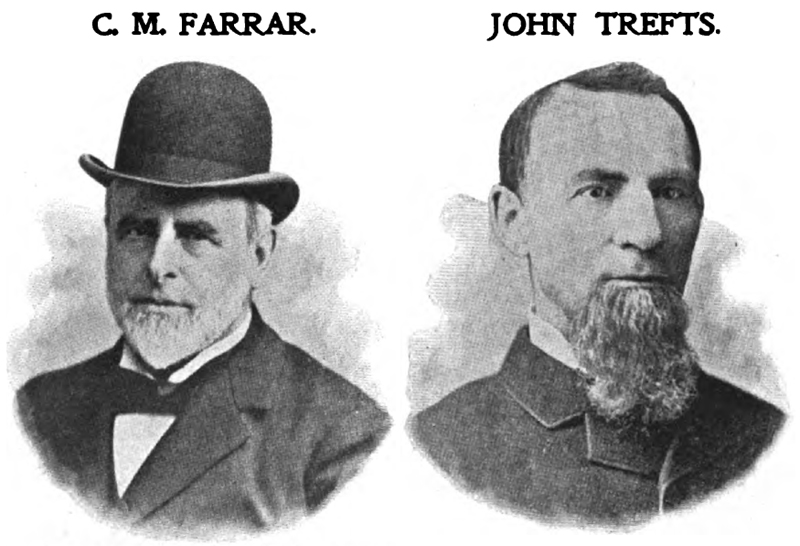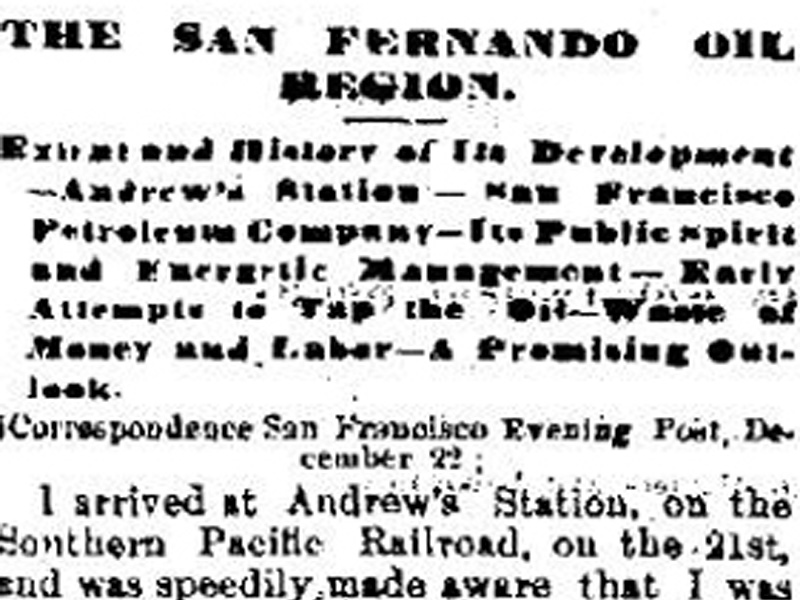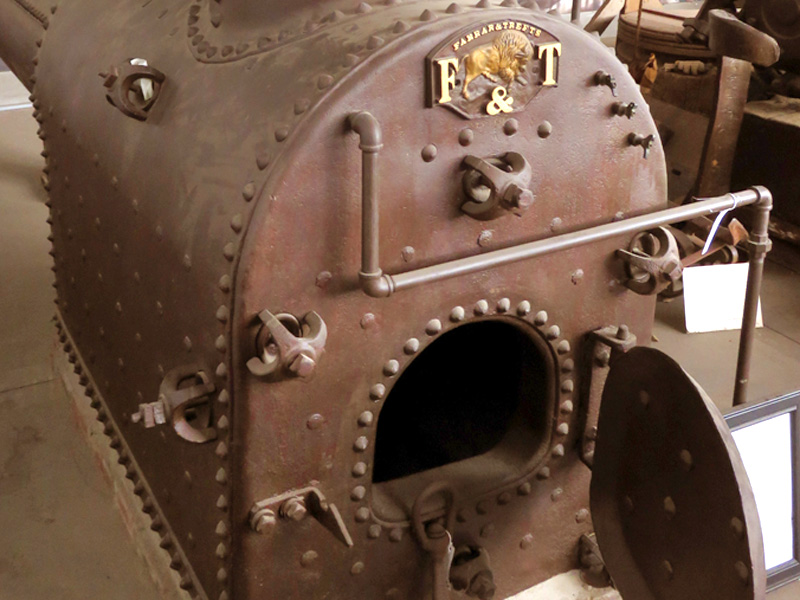|
|
California Oil Museum | Santa Paula
|
March 1, 2015 — A 15hp Farrar & Trefts boiler from the Pico oil field is used in the 1890s drilling rig at the California Oil Museum in Santa Paula. According to the museum, the rig was cobbled together from parts found in the Pico and Ventura County oil fields in the 1940s. The demonstration rig, housed in its own building at the museum, shows how steam from the boiler would power a 15hp Farrar & Trefts engine, which turned the wheel that drove the walking beam that raised and lowered the cable tool. We don't know the exact provenance of the boiler. It's possible — even likely — that this is the boiler that powered the engine that Robert C. McPherson brought to Pico Canyon in early 1876 — quite possibly this one. According to Formative Years of the Far West (pp. 36-37):
A born salesman, McPherson had left Pennsylvania in 1873 after more than a decade in the oil fields and had come to California as an agent for Farrar & Trefts of Buffalo, New York, who were well-known manufacturers of steam engines and boilers. When he visited the Star Oil Works in the San Fernando [sic: Pico Canyon area] in June 1875, he may have been seeking to sell one of his engines, but it is obvious that he came away impressed by the prospects of the region. Returning to San Francisco, McPherson drummed up support for an oil venture and traveled East in the autumn to purchase up-to-date drilling equipment and to develop some 200 acres in mining claims he had acquired in and around Pico Canyon. These claims he deeded to the San Francisco Petroleum Company, which he organized in mid-December in association with Robert C. Page, a prominent stockbroker, and several other San Francisco capitalists. San Francisco Petroleum had a nominal capital of $10,000,000. ... McPerson's rig, consisting of two sets of boring tools weighing about 2,000 pounds each, fishing tools to lift the boring tools in the case of accident, and a 15-horsepower Farrar & Trefts engine, was by far the finest Californians had yet seen. He put it to work early in 1876 on the heights a scant half-mile east of Pico Springs. Antother thing McPherson did when he traveled back East to pick up the equipment was to recruit the veteran Titusville refiner John A. Scott to come out and whip (what we now call) the Pioneer Oil Refinery into shape and ultimately expand it and move it over to Pine Street from today's Eternal Valley Cemetery. The California Oil Museum in Santa Paula credits the restoration of the boiler from Pico to the late Cecil Wayne Wilson, an oil man who once worked in the Newhall area. Signage with the boiler reads: In Memory of Cecil Wayne Wilson Wayne Wilson, a Southern California native who had a lifelong association with the oil industry, was instrumental in the restoration of the California Oil Museum's turn-of-the-century rig boiler. Wayne's early days were spent in Baldwin Hills where his family lived on Baldwin Oil land; his career with Standard Oil of California lasted 37 years during which he worked in Baldwin Hills, El Segundo, the Oxnard/McGrath field, Ojai, Newhall, and Swanson River, Alaska. About Farrar & Trefts, from "The Derrick's Hand-Book of Petroleum: A Complete Chronological and Statistical Review of Petroleum Developments from 1859 to 1898" (Oil City, Penn.: Derrick Publishing Co., 1898:899):
It does not take a great deal of invention or ingenuity to build a boiler, but it does require lots of principle to build an honest one, as there is no manufactured article on which a purchaser can be so completely cheated as a steam boiler. The buyer has to depend solely on the reputation of the builder, and with this general warning we will proceed to say that Farrar & Trefts have been rewarded by the producer for their labor and enterprise. All the way down from Pithole to Whisky run, they have sold stacks of them in every field yet opened, having built, sold and delivered the enormous total of 25,000 engines and boilers up to date — just think of it! Enough to make a ferriferous fringe for one of our States if the different pieces were laid out edge to edge on the landscape. Farrar & Treft's Machinery is the most widely known, is the most popular, has the largest sale, has given the best satisfaction, is the more durable, is the most economical, has the speed record for twenty years, has smothered all competitors as fast as born, is always tuned up to concert pitch, is the easiest to sell at second hand, has the right of way in every oil field on the globe, has never lost a friend who gave it a fair trial, has outgrown everything in sight; it took some blowing to start it, it makes its own draught now; those who buy it, make a good investment; those who don't, make a mistake.
19200 dpi jpegs from digital images (photographs) March 1, 2015, by Leon Worden. |
CSOW Time Book
1887-1889
CSOW Stock Certificate 1901
SCV History Moment
Early Oil & Gas Production in Calif. (Video 1985)
Standard Oil Co. History to 1929
Description Jan. 1877
Description May 1877
Description 9-26-1882
Oil Tank Const. & Death 1883
Mentryville 1885-1891
CSO Hill 1883
Oil Works ~1885
The Pico Field 1890
PCO Hill ~1890s
CSO Jackline Plant
Farrar & Trefts Boiler
New Boiler 1893?
Mentryville 1890s-1900s
Reamer Patent 1900
Machine Shop 1910
Machine Shop 1910s
Natural Gas-to-Gasoline 1913/14
Mentryville ~1920
Pico No. 4, 1931
CSO Jackline Plant
PCO Jackline Plant Remnants
Darryl Manzer at Firehouse ~1961
Darryl Manzer at Field Office ~1961
Pico No. 4, 1961
Darryl Manzer, L.A. Times Story 1962
National Survey 1963
PCO Jackline Plant Removal 1974-75
CSO Jackline Plant 1974-75
A.C. Mentry Blacksmith Forge
|
The site owner makes no assertions as to ownership of any original copyrights to digitized images. However, these images are intended for Personal or Research use only. Any other kind of use, including but not limited to commercial or scholarly publication in any medium or format, public exhibition, or use online or in a web site, may be subject to additional restrictions including but not limited to the copyrights held by parties other than the site owner. USERS ARE SOLELY RESPONSIBLE for determining the existence of such rights and for obtaining any permissions and/or paying associated fees necessary for the proposed use.

































